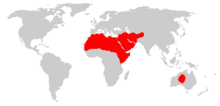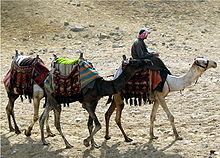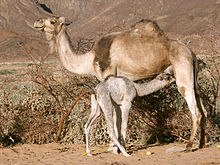Dromedary: Difference between revisions
| Line 80: | Line 80: | ||
==External links== |
==External links== |
||
* [http://www.livius.org/caa-can/camel/camel.html Livius.org: Camels and dromedaries] |
* [http://www.livius.org/caa-can/camel/camel.html Livius.org: Camels and dromedaries] |
||
* [http://www.buildingexamples.com/most-popular/49-duplo-animal-dromedary Dromedary in Lego Duplo bricks] |
|||
===Sister projects=== |
===Sister projects=== |
||
Revision as of 17:28, 11 February 2011
| Dromedary camel | |
|---|---|

| |
| Scientific classification | |
| Missing taxonomy template (fix): | Camelus dromedarius |
| Binomial name | |
| Camelus dromedarius | |

| |
| domestic dromedary range | |
The dromedary (pronounced /ˈdrɒmədɛəri/ or /ˈdrɒmədri/) or Arabian camel (Camelus dromedarius) is a large even-toed ungulate with one hump on its back. Its native range is unclear, but it was probably the Arabian Peninsula. The domesticated form occurs widely in North Africa and the Middle East;[1] the world's only population of dromedaries exhibiting wild behaviour is an introduced feral population in Australia.
The dromedary camel is a member of the camel family. Other members of the camel family include the llama and the alpaca in South America. The Dromedary has one hump on its back, in contrast to the Bactrian camel which has two.
Anatomy

Adult males grow to a height of 1.8–2.0 m, and females to 1.7–1.9 m. The weight is usually in the range of 400–600 kg for males, with females being 10% lighter. They show remarkable adaptability in body temperature, from 34 °C to 41.7 °C, this being an adaptation to conserve water.[2]
Male dromedaries have a soft palate, which they inflate to produce a deep pink sack, which is often mistaken for a tongue, called a doula in Arabic, hanging out of the sides of their mouth to attract females during the mating season. Dromedaries are also noted for their thick eyelashes and small, hairy ears.
Domestication

Dromedaries were first domesticated in central or southern Arabia some thousands of years ago. Experts are divided regarding the date: some believe it was around 4000 BC, others as recently as 1400 BC. There are currently almost 13 million domesticated dromedaries, mostly in the area from Western India via Pakistan through Iran to northern Africa. None survive in the wild in their original range, although the escaped population of Australian feral camels is estimated to number at least 300,000[3] and possibly over 1 million.[4] Around the second millennium BC, the dromedary was introduced to Egypt and North Africa. In the Canary Islands, the dromedaries were introduced recently as domestic animals.

Although there are several other camelids, the only other surviving species of true wild camel today is the Bactrian Camel. The Bactrian camel was domesticated sometime before 2500 BC in Asia, well after the earliest estimates for the dromedary. The Bactrian camel is a stockier, hardier animal, being able to survive from Iran to Tibet.[5] The dromedary is taller and faster: with a rider they can maintain 8-9 mph (13-14.5 km/h) for hours at a time. By comparison, a loaded Bactrian camel moves at about 2.5 mph (4 km/h).[6]
Uses
Dromedaries are used as a beast of burden in most of its domesticated range. Unlike horses, they kneel for the loading of passengers and cargo. Dromedaries have a reputation for being bad-tempered and obstinate creatures that spit and kick. A camel will show displeasure by stamping its feet and running.
Their hair is also used as a source material for woven goods, ranging from Bedouin tents to garments. They also have significant culinary uses: dromedary meat is consumed on a large scale in the Arabian Peninsula, Somalia, Sudan, and to a lesser extent Egypt, among other places. Milk too is used. [7]Border guards in many remote desert locations in Egypt use camels for patrols. Such mounted border guards are called هجان Haggan (pl. هجانة Hagganah).
Dairy

Camel milk is a staple food of desert nomad tribes and is richer in fat and protein than cow milk. It is said to have many healthful properties. It is used as a medicinal product in India[citation needed] and as an aphrodisiac in Ethiopia. Bedouins believe that the curative powers of camel milk are enhanced if the camel's diet consists of certain plants. Camel milk can readily be made into yogurt, but can only be made into butter or cheese with difficulty. Butter or yogurt made from camel milk is said to have a very faint greenish tinge.
Camel milk cannot be made into butter by the traditional churning method. It can be made if it is soured first, churned, and a clarifying agent added, or if it is churned at 24–25 °C (75–77 °F), but times vary greatly in achieving results. Until recently, camel milk could not be made into cheese because rennet was unable to coagulate the milk proteins to allow the collection of curds. Under the commission of the FAO, Professor J.P. Ramet of the École Nationale Supérieure d'Agronomie et des Industries Alimentaires (ENSAIA) was able to produce curdling by the addition of calcium phosphate and vegetable rennet.[8] The cheese produced from this process has low levels of cholesterol and lactose. The sale of camel cheese is limited owing to the low yield of cheese from milk and the uncertainty of pasteurization levels for camel milk, which makes adherence to dairy import regulations difficult.
Meat

A camel carcass can provide a substantial amount of meat. The male dromedary carcass can weigh 400 kg (882 lb) or more, while the carcass of a male Bactrian can weigh up to 650 kg (1,433 lb). The carcass of a female camel (or she-camel) weighs less than the male, ranging between 250 and 350 kg (550 and 770 lb). The brisket, ribs and loin are among the preferred parts, but the hump is considered a delicacy and is most favored.[citation needed] It is reported that camel meat tastes like coarse beef, but older camels can prove to be very tough and less flavorful. Camel meat is low in fat, and can thus taste dry. The Abu Dhabi Officers' Club serves a camel burger, as this allows the meat to be mixed with beef or lamb fat, improving both the texture and taste. In Karachi, Pakistan the exclusive Nihari restaurants prepare this dish from camel meat, while the general restaurants prepare it with either beef or water buffalo meat.
Camel meat has been eaten for centuries. It has been recorded by ancient Greek writers as an available dish in ancient Persia at banquets, usually roasted whole. The ancient Roman emperor Heliogabalus enjoyed camel's heel. Camel meat is still eaten in certain regions including Somalia, where it is called Hilib geel, Saudi Arabia, Egypt, Libya, Sudan, Kazakhstan and other arid regions where alternative forms of protein may be limited or where camel meat has had a long cultural history. In the Middle East, camel meat is the rarest and most prized source of pastırma.[citation needed] Not just the meat, but also blood is a consumable item as is the case in northern Kenya, where camel blood is a source of iron, vitamin D, salts and minerals. Camel meat is also occasionally found in Australian cuisine, for example, a camel lasagne is available in Alice Springs.
Health issues
A 2005 report issued jointly by the Saudi Ministry of Health and the United States Center for Disease Control details cases of human bubonic plague resulting from the ingestion of raw camel liver.[9]
Cultural prohibitions on consuming camel products
According to Jewish tradition, camel meat and milk are not kosher. Camels possess only one of the two Kosher criteria; although they chew their cuds, they do not possess cloven hooves. (See: Taboo food and drink)
History

Around the second millennium BC, camels had become established in the Sahara region but disappeared again from the Sahara beginning around 900 BC. The Persian invasion of Egypt under Cambyses in 525 BC introduced domesticated camels to the area. Domesticated camels were used through much of North Africa, and the Romans maintained a corps of camel warriors to patrol the edge of the desert. The Persian camels, however, were not particularly suited to trading or travel over the Sahara; rare journeys made across the desert were made on horse-drawn chariots.
The stronger and more durable Dromedaries first began to arrive in Africa in the fourth century. It was not until the Islamic conquest of North Africa, however, that these camels became common. While the invasion was accomplished largely on horseback, the new links to the Middle East allowed camels to be imported en masse. These camels were well-suited to long desert journeys and could carry a great deal of cargo. For the first time this allowed substantial trade over the Sahara.
In 1840 the first six camels were shipped from Tenerife to Adelaide. Only one camel survived the journey, arriving on the 12th of October 1840. The explorer John Horrocks was one of the first people to use camels to explore the arid interior of Australia during the 1840s. There are now estimated to be about a million feral camels living in Australia,[citation needed] the descendants of domesticated camels that were released or escaped. See: Australian feral camel.
Status
It is the provincial animal of Pakistan's Balochistan. [10]
See also
- Camel
- Bactrian camel
- Camel racing
- Camel troops
- Camel wrestling
- Camelops
- Australian feral camel
- Camel farming in Sudan
References
- ^ Groves, C. P. (2005). Wilson, D. E.; Reeder, D. M. (eds.). Mammal Species of the World: A Taxonomic and Geographic Reference (3rd ed.). Baltimore: Johns Hopkins University Press. ISBN 0-801-88221-4. OCLC 62265494.
- ^ Animal Diversity Web: Camelus dromedarius
- ^ "Farmnote 122/2000 : Feral camel [Western Australia]" (PDF). Retrieved 2008-04-09.
- ^ Northern Territory Government. "Feral Camel - Camelus dromedarius". Natural Resources, Environment, The Arts and Sport. Retrieved July 2, 2009.
- ^ "Creature Features - Pet Facts: Camels". Retrieved 2005-12-05.
- ^ "Camel". Retrieved 2005-12-05.
- ^ The Seventy Great Inventions of the Ancient World by Brian M. Fagan
- ^ Fresh from your local drome'dairy'? Food and Agriculture Organization, July 6, 2001
- ^ Bin Saeed AA, Al-Hamdan NA, Fontaine RE (2005). "Plague from eating raw camel liver". Emerging Infect Dis. 11 (9): 1456–7. PMID 16229781.
{{cite journal}}: Unknown parameter|month=ignored (help)CS1 maint: multiple names: authors list (link) - ^ "Symbols of Balochistan". Retrieved 2010-11-07.
External links
Sister projects
 Media related to Camelus_dromedarius at Wikimedia Commons
Media related to Camelus_dromedarius at Wikimedia Commons Data related to Camelus_dromedarius at Wikispecies
Data related to Camelus_dromedarius at Wikispecies The dictionary definition of dromedary at Wiktionary
The dictionary definition of dromedary at Wiktionary- Chisholm, Hugh, ed. (1911). Encyclopædia Britannica (11th ed.). Cambridge University Press.
{{cite encyclopedia}}: Missing or empty|title=(help)
